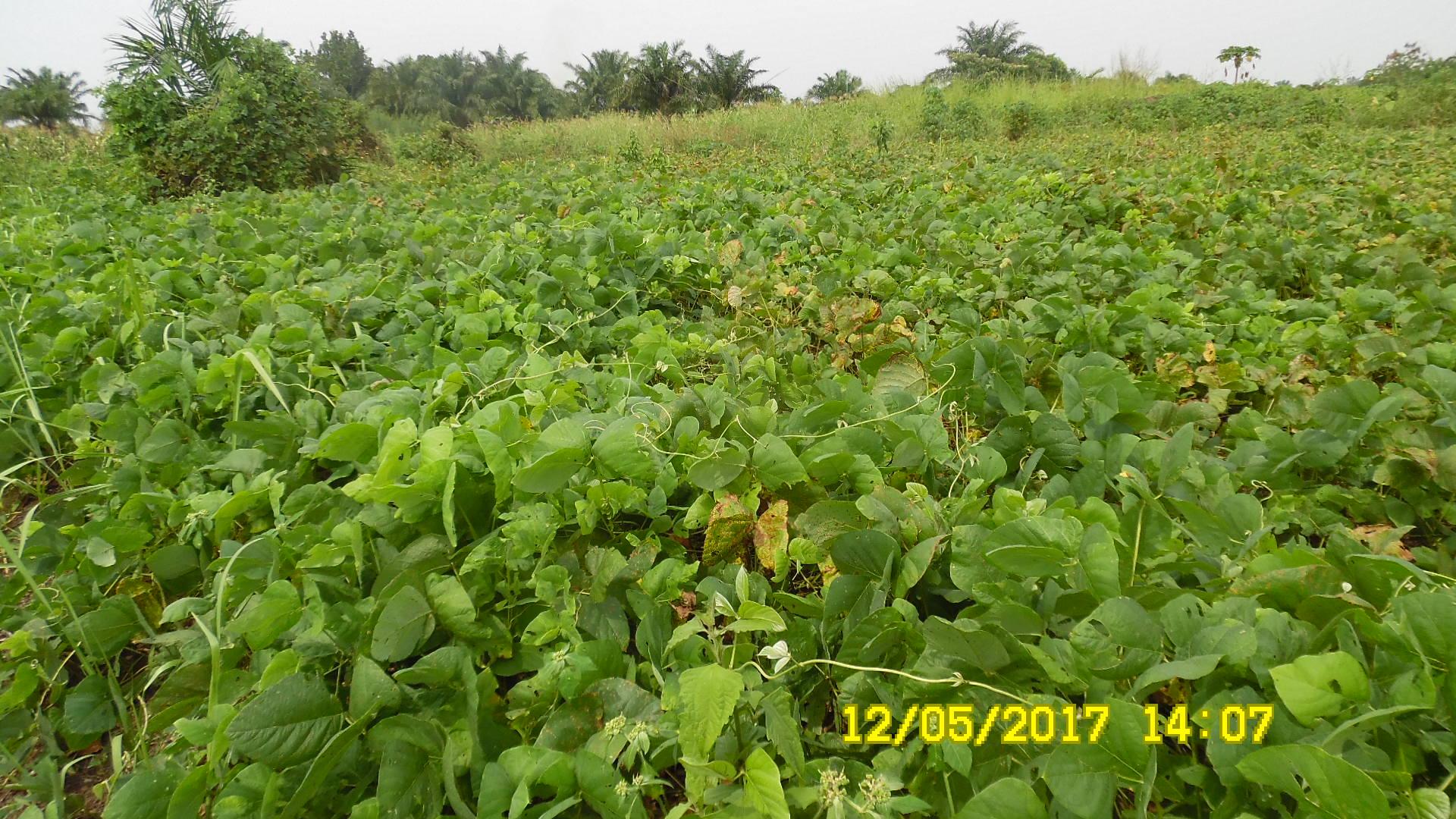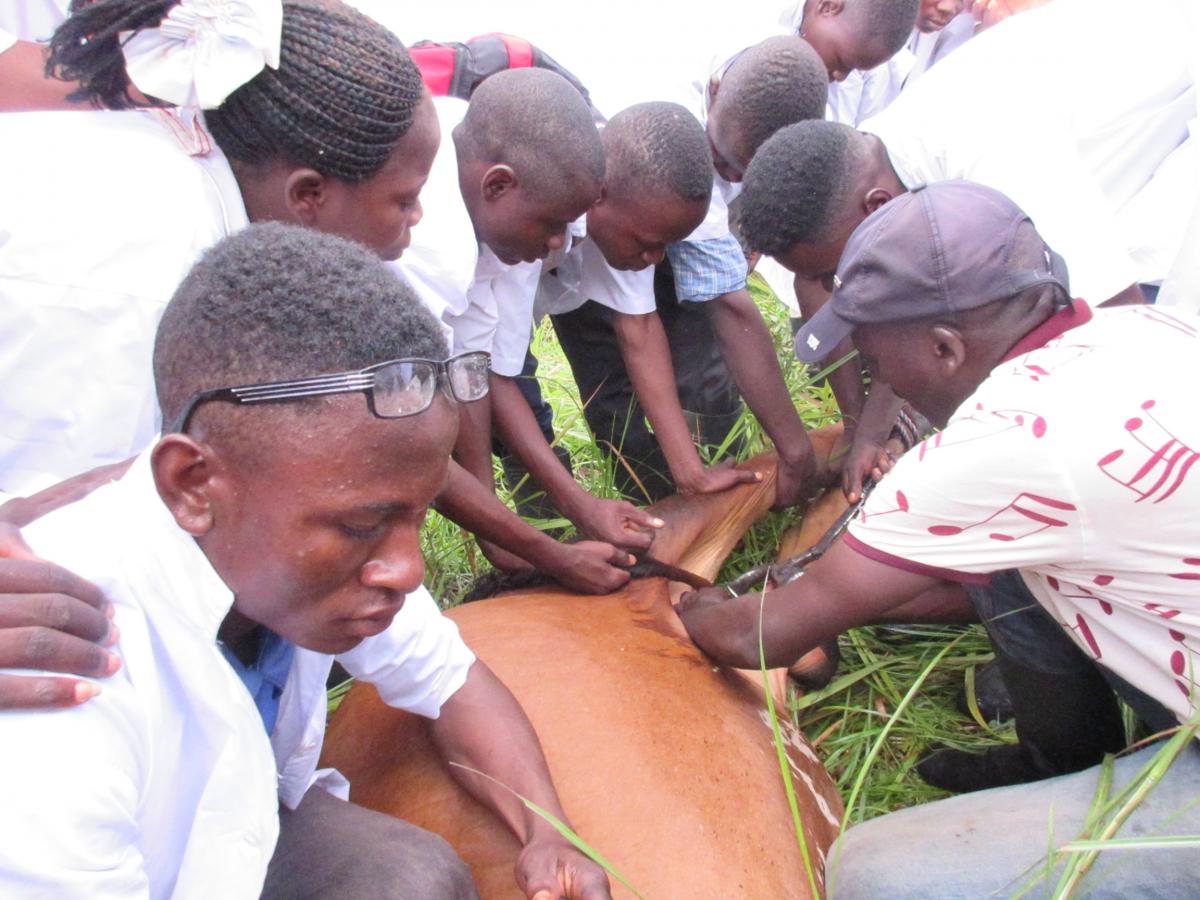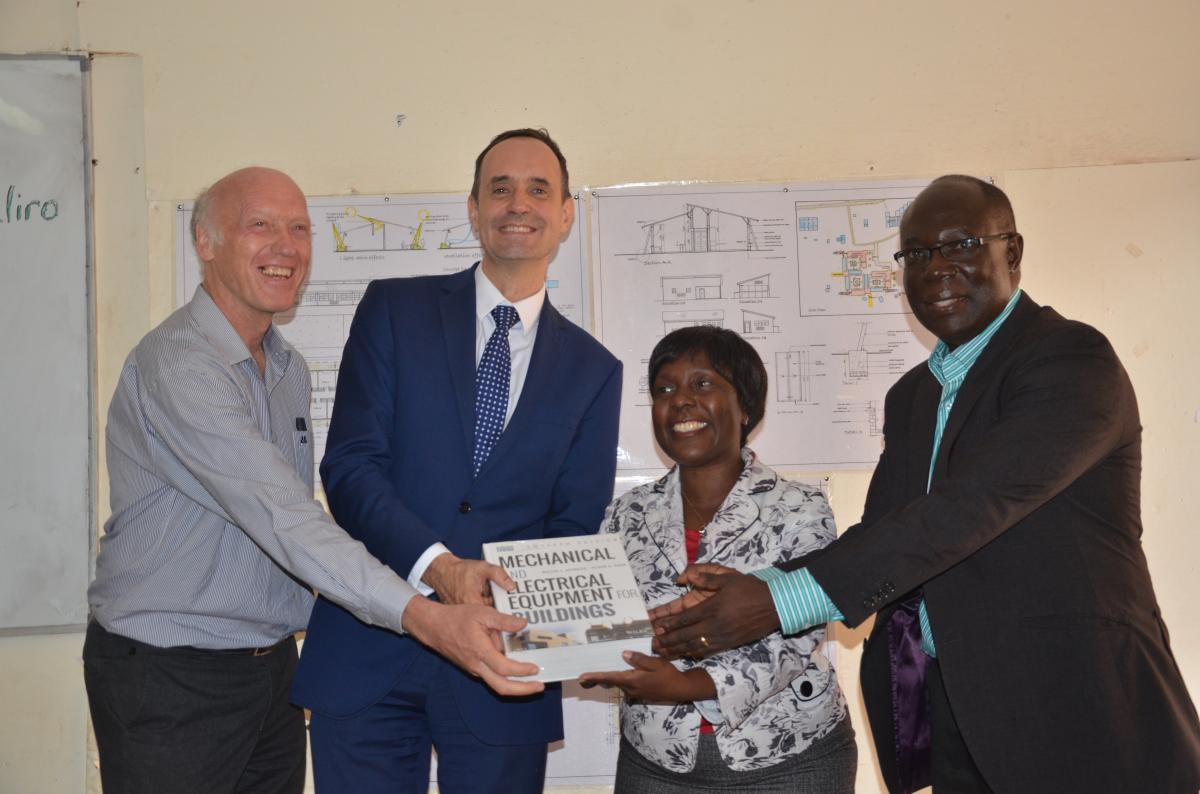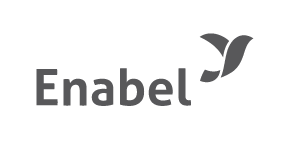Opzoeken
2010 - 2025 van 2520 nieuws bekijken
-
Les engrais verts : solution pour l’amélioration de la qualité des sols agricoles
Michael MALEMBA | 30/03/2018
Le programme d'appui au développement agricole s'est impliqué dans la productivité des cultures vivrières au Kasaï-Oriental et dans la Lomami. S’il est bien connu que le triptyque sol, plante et climat, associé à la gestion des maladies et des prédateurs sont parmi les conditions majeures de l’amélioration de la productivité des cultures, la question de la qualité des sols agricoles se pose avec beaucoup d’acuité dans les provinces du Kasaï-Oriental et de la Lomami, au Centre-Est de la RD Congo. En effet, cette zone est couverte par des savanes à Hypparhennia dans la province de la Lomami et plutôt par l’Imperata dans le Kasaï Oriental. La présence de l’Imperata est un indice de sol dégradé et acide. Par ailleurs, des analyses de sols ont montré que les sols agricoles des territoires de Ngandajika, Luilu et Kamiji étaient de type limon-sableux et limon-sableux léger avec un pH qui varie de 4,2 à 5,4. Tandis que ceux des territoires de Lupatapata, Miabi et Tshilenge étaient de type sable fin avec un pH compris entre 4 et 4,3. C’est ainsi que ces sols acides pauvres en matière organique et en éléments minéraux, sont peu favorables aux cultures vivrières. De ce fait la productivité de la culture du maïs, aliment de base dans cette région, est plutôt aléatoire. Pour faire face à cette problématique de la qualité des terres cultivables, le programme a choisi de proposer des alternatives agro-écologiques qui améliorent la qualité des sols et qui permettent aussi d’accroître le rendement du maïs. Parmi ces méthodes, il y a : la préparation du sol sans usage de feu, l’association du maïs avec une légumineuse et la jachère améliorante avec également une légumineuse qui donne plusieurs effets sur la culture de maïs. Ces pratiques apportent plusieurs effets bénéfiques à la culture du maïs, notamment : la fixation de l’azote opérée par la légumineuse, une bonne couverture du sol qui réduit ainsi l’impact des plantes adventices et facilite les travaux de sarclages, la production et la libération de la biomasse par la légumineuse, qui améliore la texture du sol. Les plantes utilisées comme engrais verts, sont notamment : Mucuna pruriens : cette plante rampante mais susceptible de s’accrocher sur d’autres végétaux avec ses vrilles, est semée 30 jours après le maïs, pour éviter qu’il n’étouffe ce dernier en s’enroulant autour ; Mucuna est utilisé aussi en jachère améliorante, pour plusieurs raisons afin de favoriser entre autre la production des graines servant à la multiplication et à la diffusion auprès des agriculteurs et pour assurer le développement, la couverture totale du sol qui a pour effet d’étouffer les plantes adventices, telle que l’Imperata cylindrica ; Là où le Mucuna se développe et grâce à sa couverture totale du terrain, aucune autre graminée ne peut se développer. La couverture du sol par les feuilles mortes qui constituent un bon humus, améliore la texture du sol, développe le complexe argilo-humique et se dégrade de manière progressive en éléments minéraux. Cette litière morte permet également de faire ensuite un semis sous couvert végétal (SCV) du maïs, sans labour, permettant ainsi de réduire les opérations de préparation du sol et d’entretien du champ. L’expérience de l’organisation paysanne de base (OPB) Kahuma dans le Territoire de Ngandajika a démontré que la qualité des matières organiques, produites et déposées par le Mucuna contribue richement aux cultures suivantes : Vigna unguiculata (niébé) : Cette légumineuse alimentaire est semée 7 jours après le semis du maïs. Il produit un effet immédiat sur la culture de maïs, car son cycle végétatif est plus court ; Arachis hypogea (arachide) : Elle est semée également 7 jours après le semis du maïs. Elle a également un effet immédiat sur la culture de maïs, grâce à l’azote atmosphérique qu’il fixe avec ses nodosités, comme le niébé. Les dates de semis des différentes légumineuses par rapport au semis du maïs ont été déterminées après plusieurs essais sur terrain, dans les parcelles expérimentales paysannes réalisées par les agriculteurs regroupés au sein d’organisations paysannes de base (OPB). En dehors du Mucuna qui n’est pas une plante alimentaire, le niébé et l’arachide permettent aux agriculteurs de tirer un meilleur profit du champ grâce aux deux récoltes simultanées qui permettent plus de revenus et une grande sécurité alimentaire. Dans le but de diversifier l’offre des légumineuses pouvant être utilisées comme engrais verts en raison de leur disponibilité dans différents milieux et dans leurs effets sur les sols et les rendements, le pois carré (Psophocarpus scandens) qui couvre bien le sol a également été essayé lors de la première saison de culture de A 2016. Le rendement moyen du maïs en association avec les légumineuses était le suivant : 903 kg/ha avec l’arachide ; 960 kg/ha avec le mucuna ; 936 kg/ha avec le pois cajan ; 972 kg/ha avec le pois carré contre 869 kg/ha dans les parcelles témoins mises en culture selon les pratiques locales. L’association du Mucuna et du pois carré au maïs semble donner des différences de rendement intéressantes par rapport aux pratiques locales, sans compter les effets bénéfiques sur la fertilité du sol pour les cultures qui suivront sur le même terrain. Les essais vont se poursuivre sur ces plantes qui sont intéressantes pour les petites exploitations agricoles, qui augmentent les productions et qui protègent l’environnement, pour une exploitation durable de la ressource « sol ». Stanis MATIA Responsable PRODAKOR
-
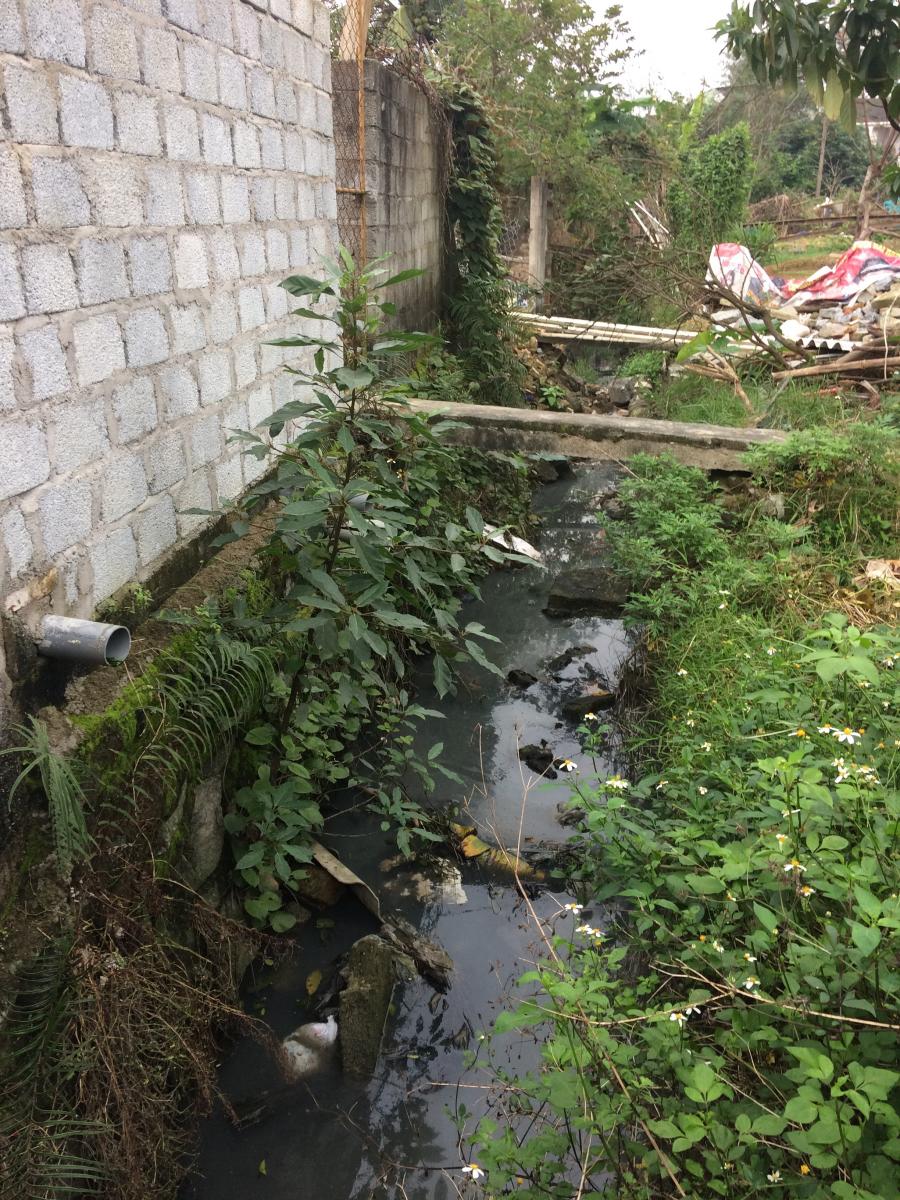
Project Analysis, evaluation and recommendation of solutions to mitigate the pollution of water environment in Nghen river towards Green Growth
Quan PHUNG VAN | 30/03/2018
Project Management Unit of Green Growth Strategy Facility (GGSF) has supported Ha Tinh province with a Project "Analysis, assessment and recommendation of solutions to minimize environmental pollution Nghen river water towards Green growth". In this moment, this project is absolutely necessary. The results of these scientific researches, if done well, will be important and input information for directing the sustainable development strategy of the province. In recent years, although the achieved economic growth is quite high, Ha Tinh has been facing a lot of serious challenges. First of all, they are the impact of climate change, risk of depletion of natural resources, increase in environmental pollution, lower development level, production efficiency, consumption, unsatisfactory to requirements for environmental friendliness. Besides, the province has not had enough fund to carry out detailed and reliable surveys or scientific calculations on level of greenhouse gas emissions, environmental pollution. Therefore, the assessment, screening, verification of the information on climate change, greenhouse gas emissions, environmental pollution levels to integrate into the process of the provincial socio-economic development - is considered to be compulsory requirement. With great achievements in economics as indicated above, on the down side of it, pollution is a challenge to the socio-economic development and pollution in Nghen river is one of them. Therefore, Project Management Unit of Green Growth Strategy Facility (GGSF) has supported Ha Tinh province with a Project "Analysis, assessment and recommendation of solutions to minimize environmental pollution Nghen river water towards Green growth". In this moment, this project is absolutely necessary. The results of these scientific researches, if done well, will be important and input information for directing the sustainable development strategy of the province. The river water is contaminated by many sources, including the following subjective reasons, such as, untreated wastewater from industrial activities, sand/mineral mining, traditional production villages, agriculture, health, animal husbandry, dosmetic waste water, ...directly discharged into the river; estimatedly, thousands of cubic meters of dosmetic waste water/day-night by about 400 thousand households discharged to the river, containing high organic content, and microorganisms, including pathogenic microorganism which is one of the main sources of pollution to water environment. Coastal and river aquaculture: River caged fish farming in Nghen helped to stablize many family lives, contributing to increase fish production. However, due to river pollution, many households in Nghen have become impecunious and stopped their farming. Caged fish farming itself is one of the main pollution sources too because it causes ecological imbalance, impacting the natural flows of the river and wastes from farming such as chemicals, medicines, fish food in to the river. In addition, there are also other unknown reasons which should be identified through surveys, reviews of scientists. Therefore, identifying pollution sources, level of water pollution and recommendation of mitigation measures, research and pilots for implementation of green infrastructure, ensuring the water treated by "green"-designed treatment discharged into rivers qualified, thereby improving the quality of Nghen river water. Basing on the reliable data given by surveys, analysis and evaluation of the scientists, to identify the opportunities and challenges. Identification of assessment, analysis will create prerequisites to propose orientations and solutions for sustainable development objectives towards green growth.
-
Le Projet Pilote de Formation en Alternance « PPFEA » : un outil bénéfique pour le territoire de Ngandajika
Michael MALEMBA | 28/03/2018
Le programme Edukor travaille en synergie avec ses partenaires institutionnels notamment : le Ministère de l’enseignement primaire, secondaire et professionnel(MEPSP), la société civile et le monde du travail, qui ont pour mission d'améliorer la qualité de la formation technique et professionnelle au bénéfice des jeunes apprenants (filles et garçons). Tout en ayant un regard particulier quant à l'accès et rétention des jeunes filles dans les filières techniques et professionnelles en vue de forger une main d’œuvre qualifiée. Ceci permettra ainsi de constituer une force pour l’avenir au service des communautés, des provinces et du pays. Dans le cadre de la vision stratégique mise en place par le programme Edukor qui vient en appuie de cinq écoles de l’Enseignement Technique et Formation Professionnelle(ETFP) et sont devenues à ces jours des Centres d’Applications (CDA), en faisant objectivement bénéficier celles-ci de renforcements des capacités de leurs RH, par la réhabilitation et la construction d’infrastructures et la dotation d’équipements pour leurs ateliers dans les filières de la mécanique générale, menuiserie, mécanique moto, agriculture générale, transformation alimentaire et vétérinaire. L’équipe EDUKOR a mise en place le « Projet Pilote de Formation en Alternance » (PPFEA) pour cette année scolaire 2017/2018, rencontrant les attentes de la RDC dans le cadre de la stratégie nationale en matière de l’ETFP.Par ailleurs, une approche innovatrice en signant des conventions avec des entreprises locales et certains services de l’état tels que : BRASIMBA, Minière de Bakwanga (MIBA), Office des routes, PRODEKA, Institut National pour l'Etude et la Recherche Agronomique (INERA), Projet Ditunga (PRODI), Action intégrée pour le Développement de Ngandajika (AIDN) et Centre d'Alevinage Principal (CAP) TSHIOJI, qui accueillent en formation en alternance 188 élèves (filles et garçons) en raison de 2 ou 3 jours par semaine pendant toute l’année scolaire afin de les permettre d’acquérir les compétences techniques du métier au sein de leurs structures. Cet apprentissage se réalise sous l’encadrement des professionnels de ces entreprises (Maîtres encadreurs) sur base d’un programme séquentiel d’acquisition de compétences établies. Les enseignants des cours techniques des CDA en synergie avec l’inspection assurent tout au long de l’année l’appui des RH (Maîtres encadreurs) ainsi que le suivi et évaluation des apprenants en alternance. C’est ainsi que les élèves des CDA, en appui d’EDUKOR, alternent pendant la semaine leur apprentissage théorique (cours généraux), puis les cours de pratique (métier) au sein de leurs écoles, dans les salles de cours, dans l’atelier, dans les laboratoires NTIC (Nouvelles Technologies de l’Information et de la Communication), dans les AGR (Activités Génératrices de Revenus), et finalement dans les entreprises et services de l’état conventionnés dans le cadre du « PPFEA ». Grâce à cette alternance au sein de ces entreprises et services de l’état, les apprenants des CDA bénéficient d'une formation pratique « in situ » qui répond aux attentes et besoins des employeurs, permettant ainsi d'atteindre une parfaite adéquation entre la formation et l'emploi préparant les jeunes sortants de la formation vers l’emploi salarial ou l’entrepreneuriat. Michel PUJANA Responsable EDUKOR
-
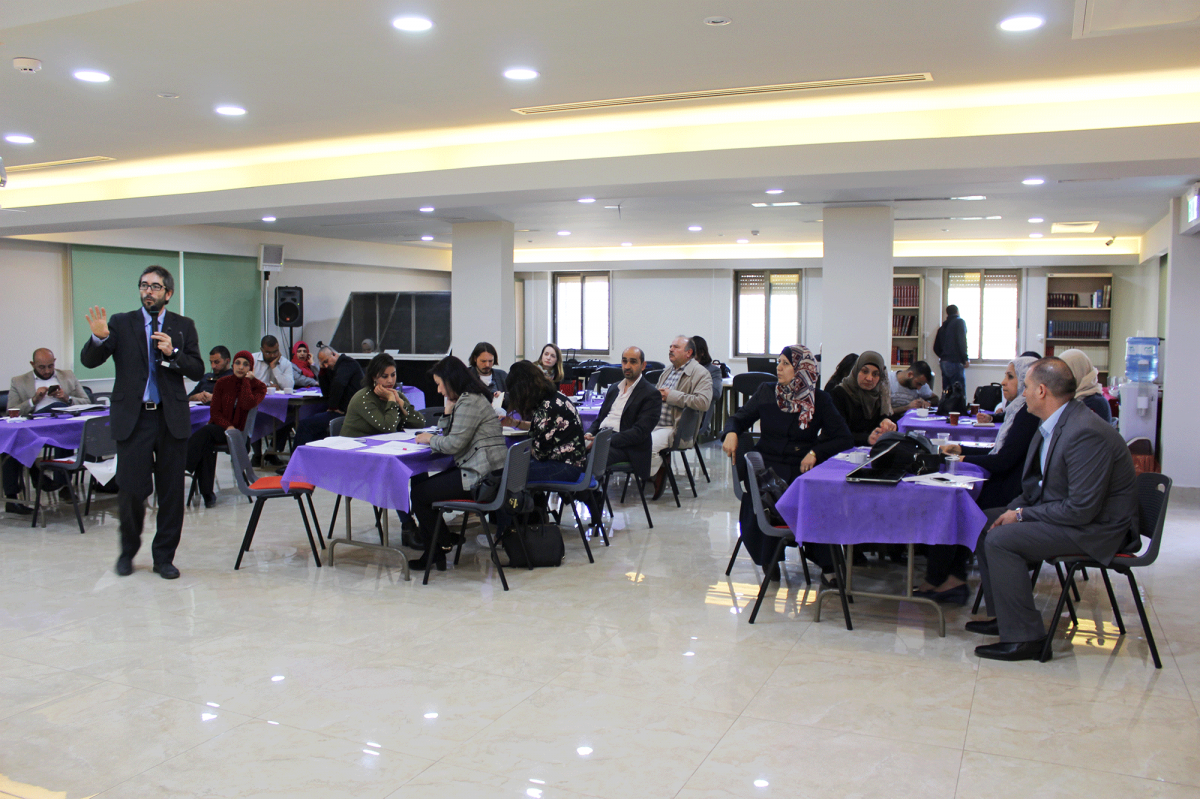
First workshop on data collection to support the implementation of a national monitoring and evaluation system for the TVET sector
Laura SCHILLEMANS | 28/03/2018
Based on the work of the Monitoring and Evaluation Technical Working Group, supported by ETF, Enabel and GIZ, a list of indicators to monitor and evaluate the TVET (Technical and Vocational Education and Training) sector in Palestine was developed. The list, which has been approved by the main stakeholders, formed the basis for the creation of a monitoring framework. The framework looks at the input (e.g. demand for TVET), the output (e.g. number of graduates from the TVET sector) and the quality of the TVET system (e.g. employment rate of the TVET graduates). In order to implement the new framework, existing monitoring and evaluation processes have to be reviewed to ensure that the necessary data is gathered and analyzed. As a pilot for 2018, the ETF is supporting the NGO VET League in going through the complete monitoring and evaluation cycle, starting with the data collection of five administrative indicators and one on the employment rate. "It is important to move from data collection to data analysis so we can identify trends and make the necessary decisions based on those" says Kristien Van den Eynde, the newly appointed ETF country desk for Palestine. On March 21, 2018, the first of three capacity building workshops, aimed at supporting the NGO VET providers in implementing the pilot, has taken place. The workshops address the topics of data collection, data analysis, result dissemination and informing decision makers. In his opening speech, Bart Horemans (International Technical Advisor for Entrepreneurship and Job Creation at Enabel), emphasized the need for the system: “A good M&E system is essential to measure the quality of our work. We need to know where we are with TVET in Palestine, what we have done, what we are doing and what we have to do: how many graduates have found a job? Do we offer quality education and training? How many new TVET vocations do we need? Where do we have to extend or build new TVET institutions? What can be improved? are only a few of the questions we need answers to.” Sabina Gebauer , Head of GIZ TVET and Employment Promotion Programme, highlighted that “M&E of the TVET sector is fundamental for improving TVET, achieving a better qualified work force, diminishing unemployment and contributing to a better performance of the private sector,” she added that “only if we know the results of previous and current training programmes in terms of quality and employment, we can make informed decisions about the best way forward.” Yousef Shalian, Chair of the VET League emphasized that the NGO VET League is committed to cooperate with the different stakeholders, especially with Ministry of Education and higher Education and the Ministry of Labour, through the TVET Higher council and the TVET development center, to achieve the creation of the M&E system. On medium term, the system will allow the NGO VET providers to have a source of comparison and a benchmark against which they can monitor their performance.On the long term, the pilot could be implemented at a national level so that all TVET providers in Palestine can use the same monitoring tools and processes.
-
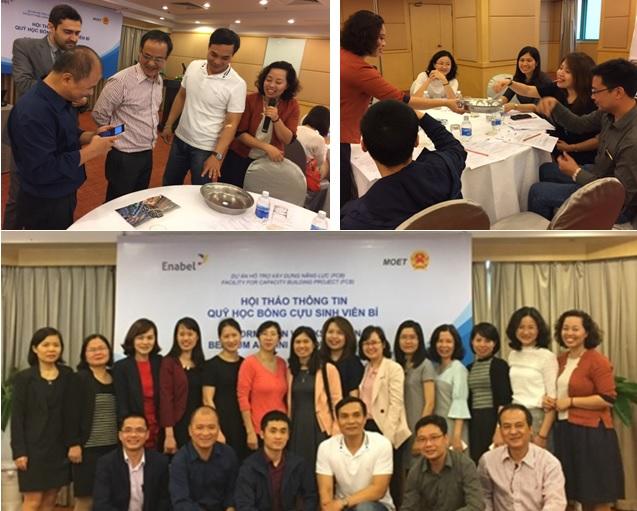
Information workshop on Belgium Alumni Fellowship Fund - Mar 2018
Huong TRANTHANH | 28/03/2018
On March 19th 2018, an information session on the Belgian Alumni Fellowship Fund was organized in Hanoi by the Capacity Building Project (FCB). Mr. Ivo Hooghe - Head of Development Cooperation, Belgian Embassy, Ms. Krista Verstraelen - Resident Representative, Enabel Vietnam and 27 Belgian Alumni who have been studying in Belgium universities including KU Leuven, UC Louvain, Liège, Ghent and Antwerp ... participated in the workshop. The Fellowship Fund is a single opportunity within the FCB project for alumni of Belgium universities and alumni of Vietnam - Belgium join training programs, to visit Belgium for professional exchanges, to implement practical researches and/or to test innovative ideas that may bring about positive changes in their organization. Together with a recent grant fund of EUR 190,000 to the Vietnam - Belgium Friendship Association, the fund aims at developing personal capacity of the alumni, promoting the professional network among Belgium alumni in Vietnam and strengthening the relations and cooperation between Vietnam and Belgium. Attending the workshop, alumni are presented with information about terms and condition of the Fellowship fund. The sharing of two alumni attracted great attention on how to best present the logic of the proposed activities, how it can contributes to the achievement of the Fund's objectives and the development of Vietnam in general. Many queries were raised in the Q&A session, which showed great interest in the fund. Many interesting research ideas, application of international practice and innovations in academic environment of Vietnam, networking for professionals and connections between Vietnam and Belgium universities were shared and discussed.
-
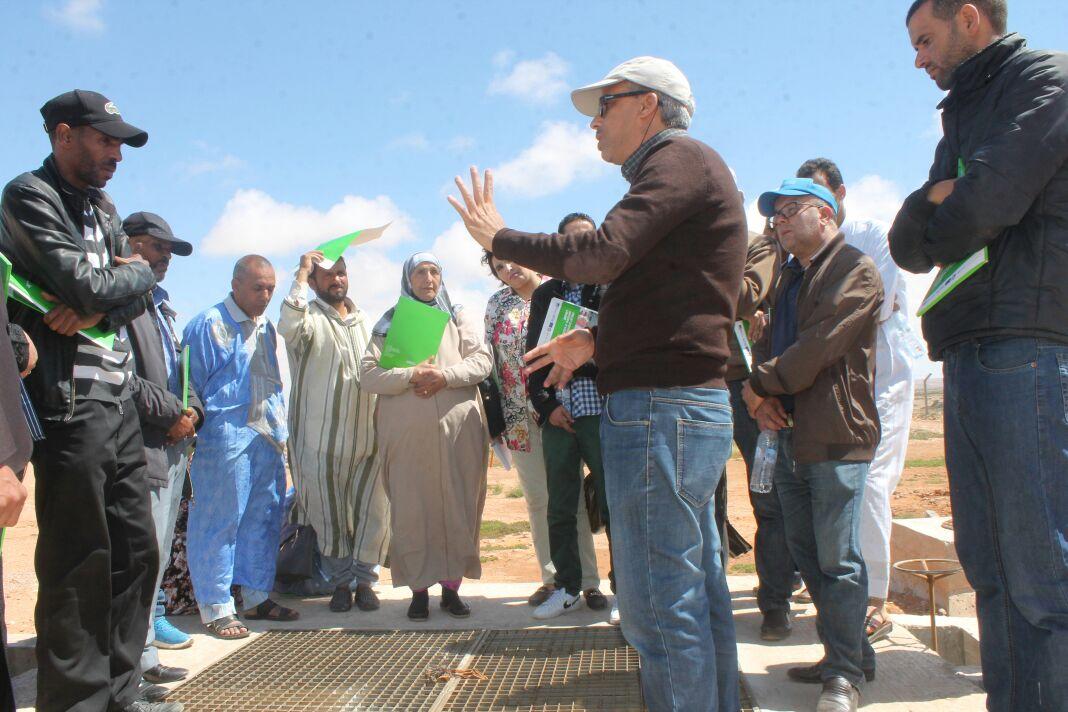
Une gestion de l'eau sensible
Meriem HILALI | 22/03/2018
En cette journée mondiale de l’eau, notre partenaire l’Office National de l’Eau et l'Électricité organise en collaboration avec Enabel une journée sur l’eau, l’assainissement et l’accompagnement social des projets de gestion de l'eau. Cette journée fait partie d’un ensemble d’activités de sensibilisation sur des thématiques telles que l’importance de la collecte, du traitement et de l’évacuation des eaux usées, mais aussi sur l’importance de l’eau en général et les bonnes pratiques face à ses infrastructures. Les bénéfices du programme d’assainissement sont considérables car ils touchent l’amélioration des conditions sanitaires et environnementales. Ces actions de sensibilisation permettent l’adhésion des populations et donc d’assurer la durabilité des services fournis par notre partenaire. Dans cette même thématique, nous avions également organisé la semaine dernière deux visites de stations d'épuration des eaux usées (STEP) pour des élus et la société civile. La première visite s'est déroulée à la nouvelle STEP de Midar (au nord du Maroc) au profit des associations et élus de la ville. L'objectif du projet dans cette zone d'intervention est l’extension du réseau de 44 km, la réalisation de la station d’épuration basée sur un système naturel et de 2 stations de pompage, ainsi que le raccordement de 1 000 nouveaux bénéficiaires. La seconde concernait la STEP et station de pompage du centre El Ouatia (au sud-ouest du Maroc) et a réuni 15 associations et 10 membres du conseil communal. De plus, des actions de sensibilisation ont été menées en faveur des nouveaux raccordés du centre Lakhssass (au sud du Maroc).
-
Supporting Education Through Sustainable Infrastructure
Dorothy KYAMAZIMA | 22/03/2018
Over 1300 students and teachers from National Teachers College (NTC) Kaliro stand to benefit from the infrastructural renovations and constructions by the Ministry of Education and Sports and Enabel, the development agency of the Belgian government.Under the Teacher Training Education project, Enabel, formerly known as the Belgian Technical Cooperation seeks to improve institutional and pedagogic development and provide access to quality training and learning facilities in National Teachers Colleges. This has led to infrastructural developments in a number of NTCs across the country with the aim of creating safer learning environments that will improve learning. The work at NTC Kaliro will focus on the rehabilitation of existing accommodation for both students and staff, construction of new accommodation, sports facilities, an education block and provision of furniture and equipment for the facilities. This intervention has however not only benefited NTC-Kaliro but also partnering organisations like Makerere University. A recent event at the University saw the Belgian Ambassador H.E Hugo Verbist donate a set of architectural books to school of Built Environment (College of Engineering Design Art and Technology-CEDAT). This was as an appreciation for their participation in the Architectural Students Design project that produced creative designs and blue prints for NTC –Kaliro accommodation improvements. A number of top students with winning ideas and designs also received a prize of one and half semester tuition fees. The idea of engaging students was intended to involve young minds with creative ideas but also to provide them with the opportunity to develop practical experience and build their abilities in the area of design. “This activity was very interesting because we could offer our consultants new and creative user-friendly ideas for sustainable accommodations,” Jan Van Lint, head of the Enabel Infrastructure Unit said. While addressing the students and staff at CEDAT, the Belgian Ambassador; H.E Hugo Verbist noted that the intention of this project was to think out of the box and challenge the current practice of architecture by going beyond aesthetics and creating modern facilities that emphasized the importance of sustainability, energy efficiency and respect for natural environment.This competition also involved students from Uganda Martyrs University to refurbish existing student’s accommodation at National Teachers College Muni in Arua.Enabel also supports the education sector in Uganda through teacher training education that focuses on organizational and capacity development of teacher trainees at National Teacher Colleges.
-
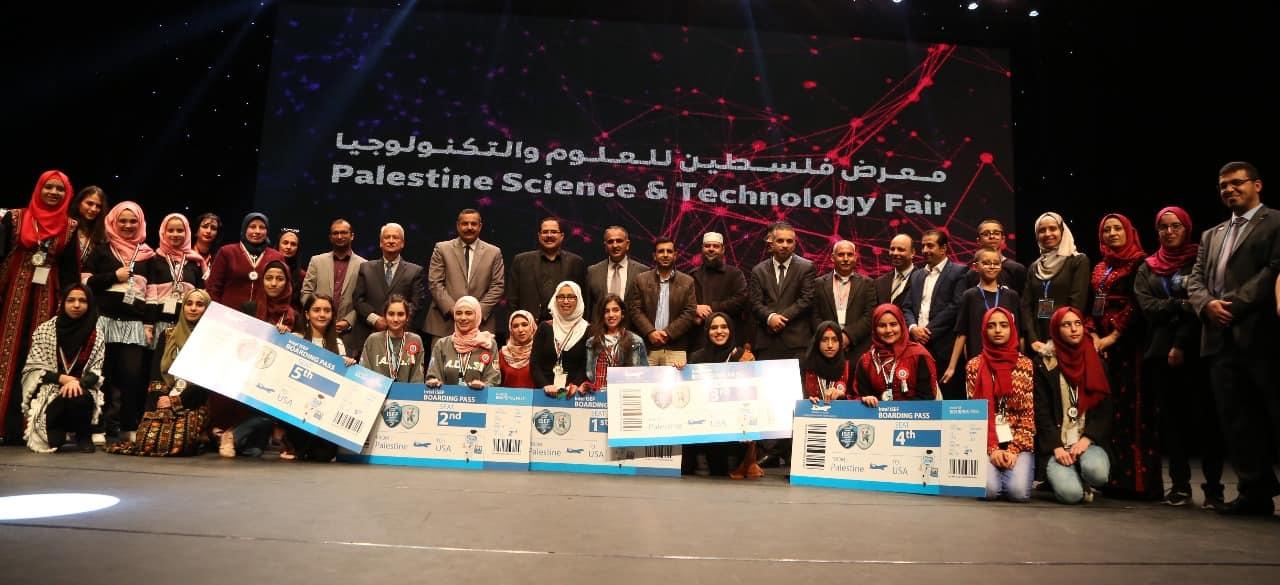
The Joint Financing Arrangement (JFA) supported the 8th edition of the Science and Technology Fair
Laura SCHILLEMANS | 22/03/2018
On the 11th of March, The Palestinian Ministry of Education and Higher Education held a highly successful 8th edition of the Science and Technology Fair with the support of the Joint Financing Arrangement (JFA), a pooled fund of Belgium, Finland, Germany, Ireland and Norway to support the implementation of the Education Sector Development Plan. Out of 1300 project across the West Bank, 5 laureates were selected to participate in the global ISEF (International Science and Engineering Fair) competition in the US in May. The Ministry of Education and Higher Education has been focusing on smart learning and innovation through STEM and e-learning activities for years. These activities are believed to develop the capacity of students and teachers, to equip them with the twenty-first-century skills, and to develop creativity and excellence needed in a demanding and competitive world. The Palestinian Ministry, together with Enabel, received the first 'Prize Digital for Development (D4D)' in Belgium at the end of 2016. The prize was awarded to the Palestinian Ministry of Education and Higher Education for their attainments in the E-learning project: https://open.enabel.be/en/PSE/2175/219/u/palestinian-e-learning-project-wins-belgian-digitalisation-...Belgium continues to support the Ministry to promote STEM and digitalization through the Joint Financing Arrangement through the following activities: Enhancing internet connectivity in more than 100 schools in remote areas Training over 6000 teachers in designing computerized units and lessons, and in technology and science Equipping more than 150 technology labs Equipping more than 50 science labs Supporting national competitions and fairs in science, technology, and mobile apps Equipping over a 100 computer labs.
-
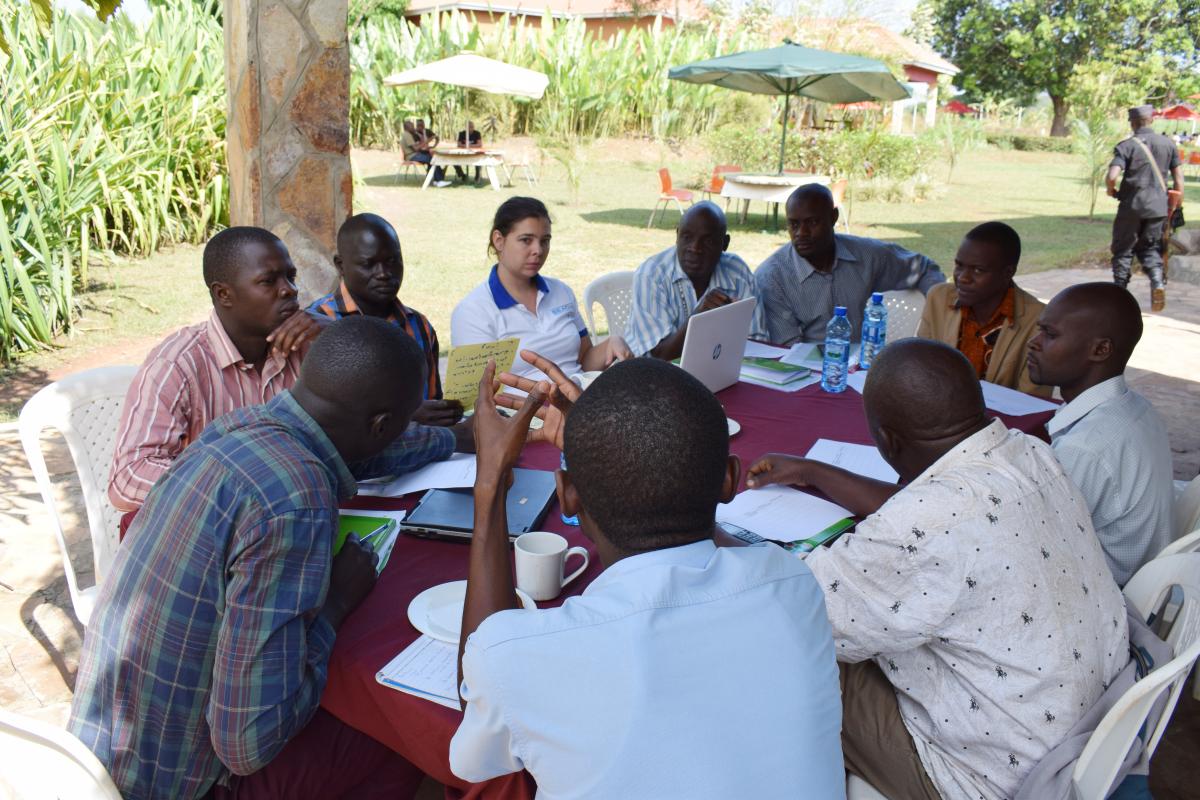
PPP IN SKILLS DEVELOPMENT: MAKING IT HAPPEN
William YEKA | 14/03/2018
It is a sunny Friday afternoon in Uganda’s South-Western District of Masindi and a seemingly contented Sam Kasangaki holding a notebook and pen emerges out of a room which has been the venue of a workshop for 5 days now. Sam is the director of a local company called Farmers Engineering Solution Limited. “I have been trained in the establishment of relevant public-private partnerships in skills development. Previously, we in the private sector never knew how to coordinate our activities with the training institutions,” says Sam. Sam is one of the 60 stakeholders of the Support to Skilling Uganda (SSU) project trained on public-private partnership (PPP). The workshop exposed participants to the benefits of PPP in skills development while exploring the challenges and success factors for partnership. Any partnership should have clear roles and responsibilities for each party and to make this happen, participants were equipped on how to develop a memorandum of understanding and other tools. Participants included Directors and Instructors of Vocational Training Institutions (VTIs), Ministry of Education and Sports (MoES) officials, Private Sector companies and Business Membership Organisations such as Uganda Small Scale Industries Association (USSIA). Sam is a master craft person (MCP). MCP is a skilled individual of the private sector employed in a particular trade such as welding and metal fabrication. Like other MCPs, Enabel trained him so that he could pass his knowledge and skills to trainees in VTIs. This was aimed at addressing the disconnect between the training offered by VTIs vis –a- vis the needs of the labour market which has rendered many graduates unemployed. Mwesigwa Robert, the Director of Millennium Business Institute in Hoima District confirms that many of his graduates are unemployed. “Only 40% of my trainees get employed after graduation. The remaining 60% is not absorbed due to reasons such as the inability to use the latest technology in the industry,” says Robert. He attributes this to the absence of a formal and well-defined partnership between his institution and the private sector. Robert says if such partnership existed, they would have had an opportunity to engage with the private sector on how to align their training to labour market needs. He says this would result in the production of graduates with the skills that the private sector requires. He, however, expresses relief that the PPP workshop has positioned them to change the status quo. “We now know who to partner with, the area of partnership and how to formalize this relationship,” says Roberts. He says the benefits of such partnership are enormous, describing it as WIN-WIN-WIN. Robert explains that working with the private sector will enable training institutions to improve the quality of their training leading to the production of more employable graduates. As for the private sector, it will have quality employees who will not need additional training which would otherwise be a cost to the business.The PPP workshop is part of the initiatives under the SSU intervention implemented by Enabel aimed at promoting partnership between training institutions and the labour market. The project is implemented in three regions of Uganda namely; Albertine/Rwenzori, Karamoja and Northern Uganda. The overall objective of SSU is to enhance the employability of Ugandan youth through better quality of instruction and training in skills development.
-
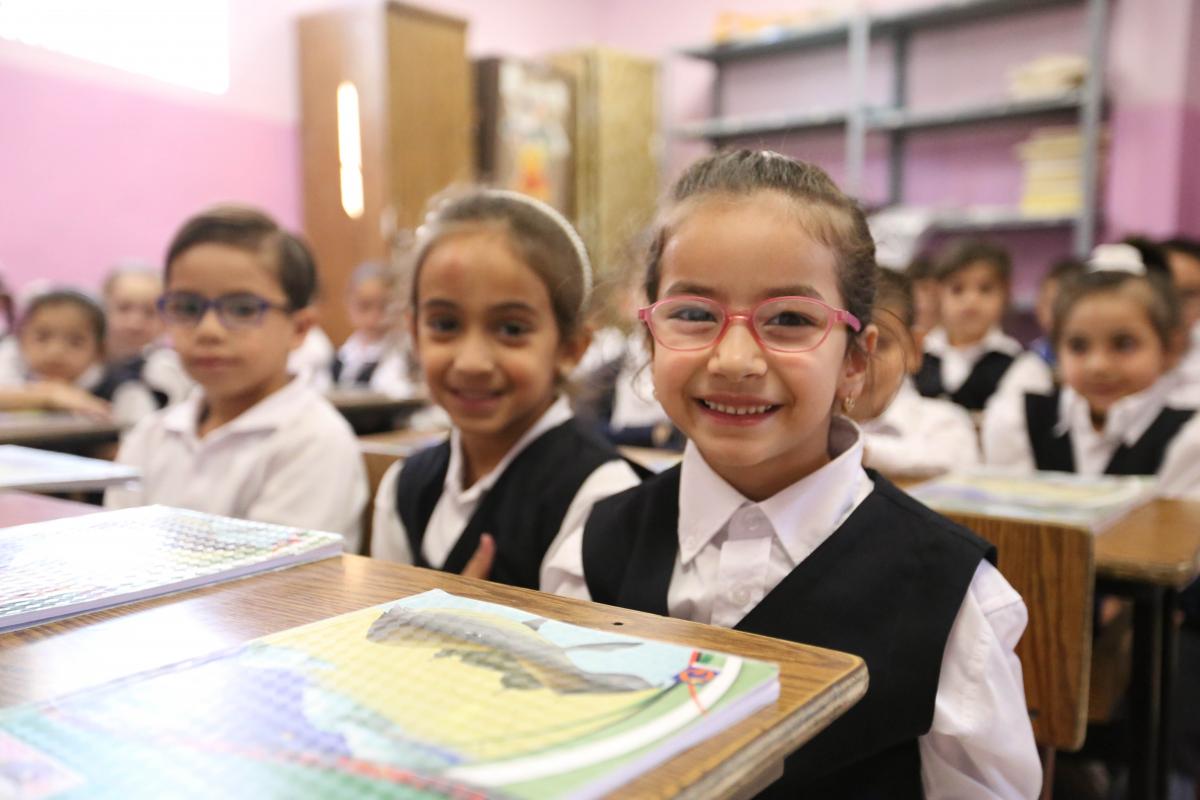
Conclusions from the external mid-term review of the JFA
Laura SCHILLEMANS | 12/03/2018
Since 2013, Belgium is part of the Joint Financing Arrangement (JFA) for Education, together with Finland, Germany, Ireland and Norway. The pooled fund, which is the single largest donor of the education sector, provides financial and technical support for the implementation of the Palestinian Authority’s education sector development plan. At the end of February 2018, an external mid-term review was concluded and the results were presented to and discussed between the partner countries and the Ministry of Education. Conclusions of the report highlight the major role the Joint Financing Partners are playing, as a group, in the implementation of the education sector plan due to their technical expertise, the financial weight they carry, and their establishment of a valuable partnership with the Ministry. A highly harmonized approach was made possible because the JFP’s are ‘like-minded’ and therefore they have been willing and able to coordinate and speak with one voice. “The dialogue between Joint Financing Partners and the Ministry has always been open – nothing is left off the agenda, even the difficult and sensitive topics. This openness can be associated to several factors. The JFA has been long-standing and the JFPs have shown to be very reliable partners that have also demonstrated strong sectoral expertise.” the consultants highlighted.In the report, the consultants also recommended to continue with the JFA and to strengthen it operationally, in order to further enhance the strategic management of the Ministry of Education, based on improved management instruments, based on a stronger integration of policy development, planning & budgeting, and monitoring & evaluation.
-
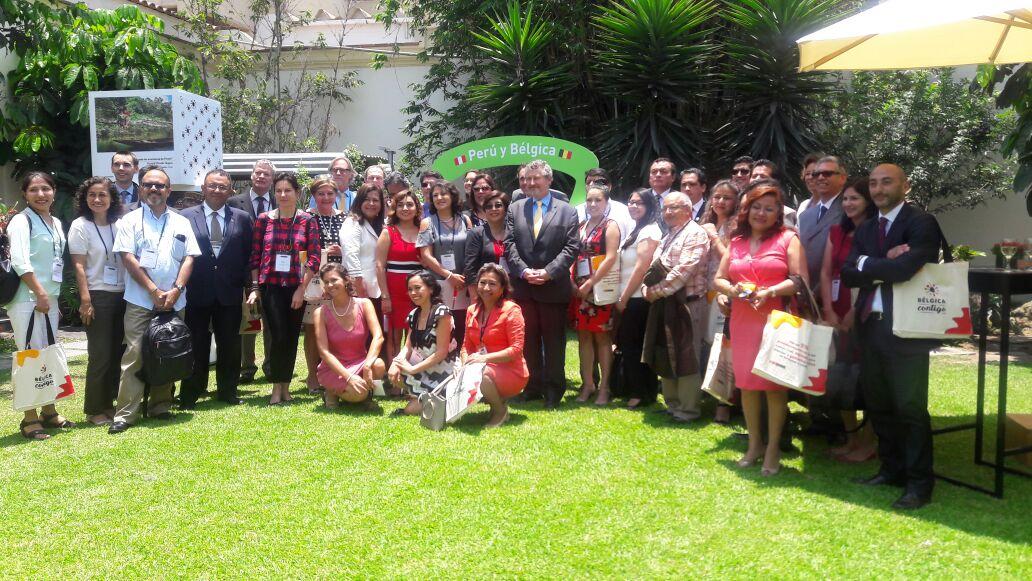
Cierre del Programa de Apoyo a la Política de Aseguramiento Universal en Salud en el Perú - Componente de Apoyo Presupuestal - SISFIN
Véronique GERARD | 09/03/2018
· A fines del año 2013, el Estado Peruano suscribió con el reino de Bélgica un Convenio de Financiación con el objetivo de Brindar apoyo financiero al Programa Presupuestal Salud Materna Neonatal para contribuir en la implementación de la Política de aseguramiento universal a través del Seguro Integral de Salud · El programa concluye formalmente sus actividades el 6 de marzo 2018, después de 4 años de ejecución· El monto total de la transferencia de apoyo presupuestal es € 6 500 000, que equivalen en moneda nacional a 23,5 millones de soles. Asistencia técnica internacional y nacional completó este monto durante unos 3 años y medio. · El monto donado por el Reino de Bélgica ha sido destinado a financiar intervenciones del Programa Presupuestal Salud Materno Neonatal en los departamentos de Amazonas y Cajamarca, para los cuales la Dirección General de Presupuesto Público con participación del Seguro Integral de Salud, suscribió Convenios de Apoyo Presupuestario. · Los Convenios de Apoyo Presupuestario, condicionaron la transferencia de recursos al cumplimiento de mejoras en la gestión, tales como la Programación Operativa, la disponibilidad de insumos y equipos, la organización de los servicios y el seguimiento de las acciones desarrolladas en establecimientos de salud ubicados en el 40% de los distritos más pobres del departamento y adicionalmente al cumplimiento de metas de cobertura de servicios claves del programa Salud Materno Neonatal.· Entre los años 2014 y 2018, los Gobiernos Regionales de Amazonas y Cajamarca recibieron respectivamente 12,18 y 11,22 millones de soles como fondos adicionales por el SISFIN.· Como parte de la mejora de gestión podemos destacar:- Más del 95% de establecimientos de salud estratégicos ubicados en los distritos más pobres cuentan al menos con el 75% de equipos e insumos críticos para la atención prenatal, el parto y la atención del recién nacido.- 90% de niños son captados antes de los 30 días y registrados en el padrón nominal, lo que les facilita a todos los servicios que se brinda en los establecimientos de salud- Más de 90% de gestantes son afiliadas al Seguro Integral de Salud (SIS) en el primer trimestre, lo que les permite el acceso a la atención oportuna al 80% de ellas en Amazonas y al 77% en Cajamarca.- Uso intensivo de información para el seguimiento de los compromisos y las metas, los que permitieron una mejor toma de decisiones· Las mejoras en la gestión de los servicios permitió incrementar la cobertura de servicios claves del programa Salud Materno Neonatales tales como:- Se ha incrementado el porcentaje de mujeres afiliadas al SIS de distritos de quintiles 1 y 2 de Amazonas y Cajamarca que tienen 4 exámenes auxiliares en el primer trimestre y al menos 4 atenciones prenatales con suplemento de hierro y ácido fólico, entre los años 2013 y 2017 de 1% a 31% en Amazonas y de 0% a 29% en Cajamarca.- Se ha incrementado el porcentaje de gestantes afiliadas al SIS de distritos del Quintil 1 y 2 que tienen parto institucional en Establecimientos de Salud con mayor capacidad resolutiva, entre los años 2013 y 2017 de 53% a 66% en Amazonas y de 56 a 71% en Cajamarca.- Se ha incrementado el porcentaje de mujeres afiliadas al SIS de distritos del quintil 1 y 2 que recibieron consejería en Planificación Familiar, entre los años 2013 y 2017 de 30% a 50% en Amazonas y de 45% a 57% en Cajamarca.· Los Recursos transferidos y ejecutados por cada una de las regiones, están disponibles en la consulta amigable del gasto del Ministerio de Economía y Finanzas.· Hacer incidencia en la política de acceso universal a servicios de salud de calidad, eso era también el mandato del SISFIN. Así que durante el Convenio, se ha promovido el dialogo y la Concertación con las diferentes instancias, tanto en el nivel Nacional con la participación del Ministerio de Salud, el Seguro Integral de Salud, la Superintendencia de Salud y la Cooperación Técnica Belga a través de un comité de seguimiento.Por otro lado, la experiencia del SISFIN deja también resultados sobre el uso del apoyo presupuestario, la modalidad de cooperación utilizada, como herramienta muy poderosa en este contexto. El efecto palanca que genera una intervención de este tipo visa a generar en paralelo fortalecimiento institucional y gobernabilidad.De esta forma, el "SISFIN" llega a su fin con logros muy satisfactorios en Salud Materno Neonatal en Amazonas y Cajamarca y en colaboración interinstitucional.Compartimos las fotos del evento de cierre del SISFIN el pasado 2 de marzo, en el que estado, cooperación y sociedad civil se reunieron: Embajada de Bélgica en Lima, Mesa de Concertación para la Lucha contra la Pobreza, Ministerio de Economía y Finanzas, Seguro Integral de Salud- SIS, CTB Perú, Gobierno Regional de Cajamarca y de Amazonas. Ver detalles del evento: https://www.facebook.com/pg/Belgicacontigo/photos/?tab=album&album_id=1790771964562307.INFORMES:Los informes de ejecución y evaluación son disponibles en el sitio web del Ministerio de Economía y Finanzas: https://www.mef.gob.pe/es/convenios-de-apoyo-presupuestario?id=3637Gracias Geert, gracias Ellen por su excelente trabajo!
-
SISFIN se despide de Amazonas
Véronique GERARD | 09/03/2018
El lunes 5 de marzo, en la ciudad de Chachapoyas, tuvo lugar una reunión de cierre del Programa de Apoyo a la Política de Aseguramiento Universal de Salud - SISFIN, financiado por el Reino de Bélgica. En dicha reunión de trabajo se expuso los resultados del estudio de investigación-acción de los procesos decisionales en las Unidades Ejecutoras de la Región Amazonas dentro del marco del convenio al Programa Presupuestal Salud Materno Neonatal. Se contó con la participación del Dr. Adolfo Gushiken y el Dr. Geert Haghebaert, por parte de la Cooperación Belga, además del Gerente General del Gobierno Regional de Amazonas Dr. Yesper Saravia Díaz, el Director Regional de Salud Amazonas Dr. Pershing Bustamante Chauca y representantes de las Unidades Ejecutoras de Salud y los Coordinadores de los Programas de Salud Materno Neonatal.Leer los detalles y fotos de la reunión: https://www.facebook.com/Diresamazonasoficial/posts/210139459541902
-

Ecoutez Lucie Kibibi, technicienne formatrice en informatique!
Julie CLAASSENS | 09/03/2018
Pendant la Journée internationale de la femme, Enabel en RD Congo laisse la parole à Lucie Kibibi, une technicienne et formatrice qui donne des cours d'informatique au sein du centre de ressources à Lubumbashi. Ce centre a été mis en place par le programme d'éducation #edukat et accompagne des apprenants dans leur parcours de formation, comme dans leur recherche d'un emploi.Vive les femmes fortes du Congo qui agissent pour enrichir la vie des jeunes!
-
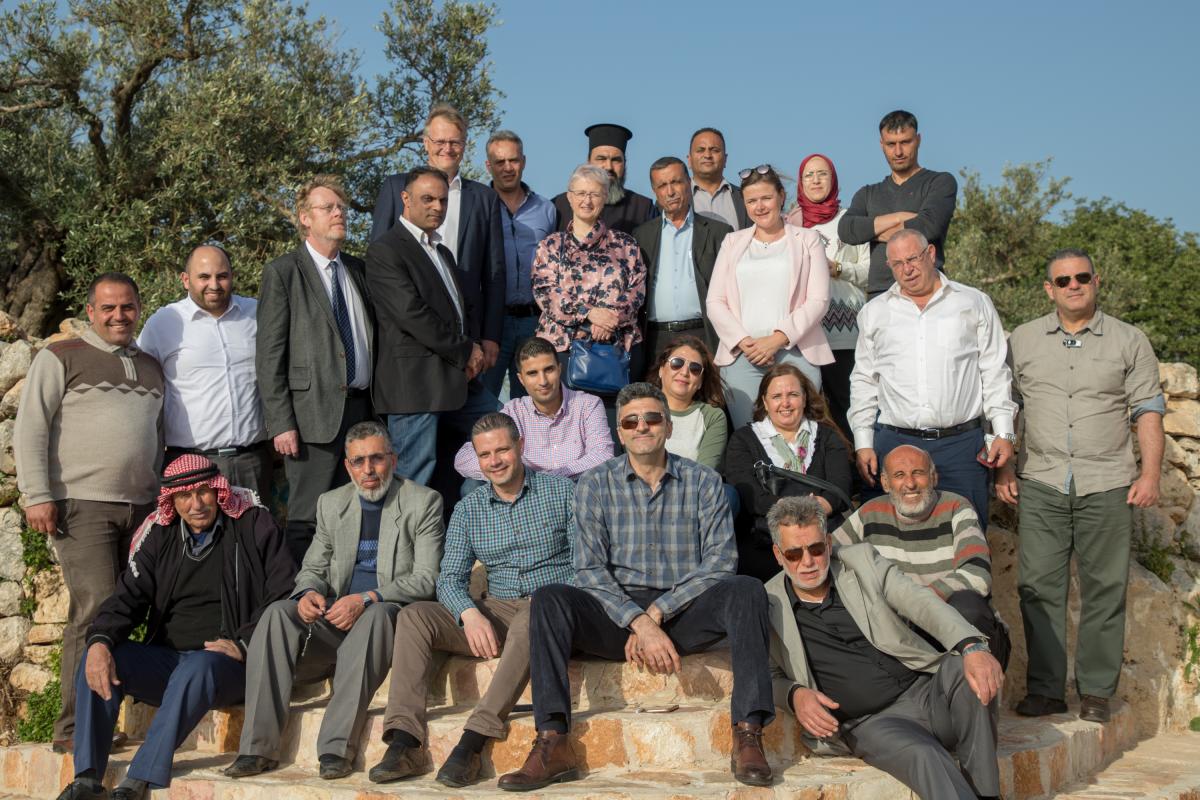
Celebration of the Palestinian Environment Day with Mrs. Danielle Haven, Consul General of Belgium
Laura SCHILLEMANS | 07/03/2018
On Monday the 5th of March, Mrs. Danielle Haven, Consul General of Belgium, visited the local governance projects in Beit Leqya, Bani Zeid and Abud. In Beit Leqya she also celebrated the Palestinian Environment Day. The day started with a meeting with Dr. Tawfiq Al-Budairy, Director General of the Municipal Development and Lending Fund (MDLF). During the meeting, MDLF presented their work and highlighted the cooperation with Enabel and Belgium, with whom they partner in the local governance & regeneration programs. After the meeting, Mrs. Haven visited the Beit Leqya cluster to visit several projects implemented by the local governance project and to participate in the Palestinian Environment Day. The Joint Services Council for Planning and Development (of Beit Leqya - Kharbatha Al-Misbah) celebrated the Palestinian Environment Day by organizing many environmental activities (since the 25th of February 2018): trainings for the schools’ environmental club students on the concept and techniques of recycling, drawing on school walls in order to educate students about environmental concepts, cultivating forest trees and cleaning up the streets around the schools, with the participation of more than 200 students from five secondary schools of the cluster. Mrs. Haven celebrated the day together with the children of the cluster and she participated in cleaning the streets and painting on the walls of the school. “I am very happy to be here on this wonderful day. I am very impressed by the activities on this environmental day and by the beautiful environment of Beit Leqya. The collaboration between Enabel, the Ministry of Local Government, the Municipal Development and Lending fund (MDLF) and the Joint Services Council is excellent I am glad that I had the chance to see the different positive results they have reached through collaboration” she concluded. After Beit Leqya, the Consul General continued to Bani Zeid – Dar Khattab where she met the mayor and the women community-based organization that’s operating one of the historical buildings restored by the RHC (Rehabilitation of Historic Centers) project. The women organization works on grinding, freezing and drying traditional food products to sell them in the local market. The day ended in ‘Abud with a visit to the regeneration projects in the village: the main plaza and the path to Al-Burbara archaeological site.
-

Février 2018 : Une halte à mi-parcours pour évaluer l’atteinte des résultats du projet
Cherif AOUDJIT | 07/03/2018
Pour évaluer l’atteinte des résultats du PRCDE, un atelier a été organisé le 7 février 2018 par l’équipe du projet avec l’ensemble de ses partenaires. Cet atelier s’est déroulé à l’Institut National de Santé Publique (INSP) d’Alger, grâce à la gracieuse invitation du Dr. Youcef Laïd ainsi que du Directeur Général de l’INSP que l’équipe du projet remercie chaleureusement. Cette réunion, animée par Dick van Blitterswijk du bureau d’étude néerlandais MDF, a permis un rappel : - de la gestion de projet axée sur les résultats, - des différents niveaux de résultats fixés dans le projet : output, outcome et impact, - et de la méthode d’évaluation choisie, inspirée et adaptée de la méthode Cap Scan (scanning des capacités). Cette méthode donne un cadre analytique, basé sur un processus participatif, permettant d’évaluer et de renforcer les capacités. La session a également été l’occasion de renforcer les connaissances du groupe mais aussi, pour ceux qui n’ont pas été présents pendant le processus d’élaboration de la Baseline, de se mettre à niveau. En travaillant en sous-groupes (par résultat), les participants ont identifié les différents éléments qui renseignent sur l’avancement des différents projets par rapport aux résultats escomptés et ajouté une annotation par OB. Ces données ont été présentées en séance plénière et ont ensuite servi à alimenter le rapport annuel 2017 du projet.
